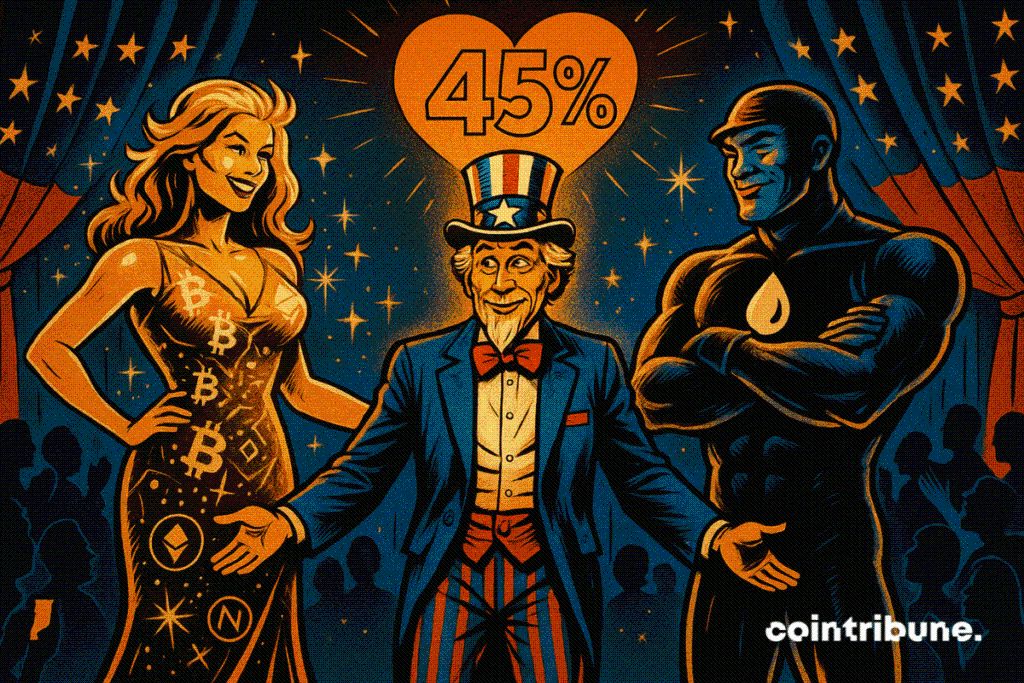Crypto, Gold, Hedge Funds US Investors Shift Strategies
The traditional landmarks of investment are faltering. Faced with market volatility and eroding confidence in classic portfolios, more and more American investors are turning away from stocks and bonds to explore assets deemed more dynamic: crypto, gold, oil, private equity. This movement reflects a profound questioning of established models, driven as much by distrust as by the pursuit of return and freedom. A structural shift confirmed by the latest figures from the Charles Schwab survey.

In Brief
- A Charles Schwab survey reveals that 45 % of American investors are interested in alternative assets like crypto, gold, or oil.
- Two-thirds of respondents believe that stocks and bonds are no longer sufficient to build a solid portfolio.
- The rise of alternative ETFs allows simplified access to these assets, with over $1,000 billion invested in the US in 2025.
- Recent regulatory developments facilitate the integration of alternative assets into saving and retirement plans in the US.
The Massive Attraction to Alternative Assets
While Trump’s tariffs caused chaos in the crypto market , a recent study published by Charles Schwab reveals a major shift in investment behaviors in the United States.
Indeed, 45 % of surveyed investors say they want to put their money into non-traditional assets, a category that includes cryptos, commodities like gold or oil, private real estate, private equity, and hedge funds.
This desire for diversification is also supported by a rejection of the conventional portfolio. “Two-thirds of respondents believe that limiting themselves to stocks and bonds is no longer sufficient”, states the report. An explicit loss of confidence in classical strategies that analysts say reflects a generational and structural turning point in wealth management.
In this context, ETFs (exchange-traded funds) play a central role. They allow investors to access these complex assets without the traditional constraints of private investments. According to State Street Investment Management, more than $1,000 billion has been invested in ETFs in the United States this year, a significant portion going to ETFs linked to gold and cryptos , CNBC reports. Several reasons explain this enthusiasm :
- Accessibility : ETFs can be bought and sold at any time, including outside market hours, unlike many private funds ;
- Liquidity : investors are no longer subject to lock-up periods or restricted redemption windows ;
- Administrative simplification : they avoid the complex formalities often associated with unlisted alternative products ;
- Controlled exposure : they allow a measured and progressive approach to more volatile asset classes.
“These private investments often have lock-up periods of several years and restricted redemption windows,” reminds Cathy Curtis, director of Curtis Financial Planning. For her, ETFs are an interesting entry point but not without limits: “for small portfolios, alternatives should be limited to 5 %. Larger portfolios can go up to 10–15 %”.
A Shift Driven by Youth and Favored by Crypto Regulation
Beyond the numbers, the survey highlights a significant generational phenomenon. Young investors, especially Millennials and Generation Z, are among the most inclined to abandon traditional saving models in favor of solutions perceived as bolder.
Charles Schwab included 200 Gen Z investors and 200 crypto investors in its panel to better capture this trend. The finding is unequivocal: a large portion of young respondents reject classical recommendations in favor of what some analysts already call a form of “financial nihilism”, where exploring new asset classes is preferred, even at the cost of greater volatility.
This shift is not only driven by individuals. It is also facilitated by the regulatory environment. The Trump administration signed an executive order in August to more easily integrate alternative assets into corporate retirement plans, a decision that could open access to these products to millions of American employees.
At the same time, the SEC has eased certain rules, notably those governing the launch of spot crypto ETFs, making their market entry faster and smoother. These two combined measures could transform investment in alternative products, expanding their adoption far beyond savvy investor circles.
While appetite for alternative assets is gaining ground as evidenced by the strong rebound of Bitcoin and Ethereum ETFs , a redefinition of investment models seems underway. Between regulatory openness and financial innovations, traditional boundaries are gradually fading, revealing a new wealth architecture, more diversified but also more demanding.